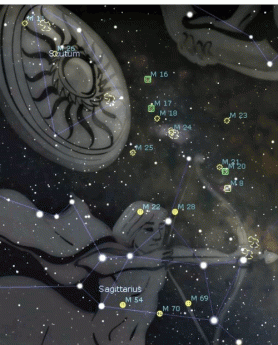This Week’s Sky at a Glance, 2024 July 6 – July 13
This Week’s Sky at a Glance, 2024 July 6 – July 13
Galaxies are favourite targets for amateur astronomers and many are visible with just binoculars. Two are seen easily with the naked eye in the southern hemisphere: the Large and Small Magellanic Clouds. The Andromeda Galaxy is a naked-eye blur for rural New Brunswickers and it looks majestic in binoculars, but there is one galaxy that is spectacular regardless of your location or observing equipment and that is our home galaxy.
The Milky Way is at least 110,000 light years across, and although it is composed of perhaps 400 billion stars we can distinguish only about 4000 unaided as individual stars from a rural area. The Sun is 27,000 light years from the galactic core, within a spur between the inner Sagittarius and outer Perseus spiral arms. When we look above the spout of the Sagittarius Teapot asterism we are looking toward the galactic core, but vast clouds of dust hide the stars between the spiral arm and the core. South of the head of Cygnus the Swan we see the Milky Way split in two by the Great Rift, one of those dust clouds.
Star formation occurs in clouds of gas and dust within the spiral arms and some can be seen as bright patches with binoculars. Just above the spout of the Teapot is M8, the Lagoon Nebula; and a hint of M20, the Trifid Nebula, can be seen in the same field of view above. Scanning to the left up the Milky Way you encounter M17, the Swan (or Omega) Nebula; and star clusters M16 in the Eagle Nebula and M11, the Wild Duck Cluster. A tour of the Milky Way under a dark sky can keep a binocular stargazer engaged for an evening.
This Week in the Solar System
Saturday’s sunrise in Moncton is at 5:35 and sunset will occur at 9:12, giving 15 hours, 37 minutes of daylight (5:43 and 9:13 in Saint John). Next Saturday the Sun will rise at 5:41 and set at 9:08, giving 15 hours, 27 minutes of daylight (5:49 and 9:10 in Saint John).
The day-old crescent Moon is above Venus this Saturday after sunset and above Mercury on Sunday. Saturn rises around midnight this week and it is seen best in early morning twilight high in the southern sky. Mars is about ten degrees lower in the east and to the right of the Pleiades star cluster, while Jupiter and Aldebaran are below the Pleiades. This scene only gets better over the month. Binocular users might be able to see Uranus less than a degree above Mars before 5 am on Wednesday.
The Saint John Astronomy Club meets in the Rockwood Park Interpretation Centre this Saturday at 7 pm. On Sunday evening at 8 pm tune in to the Sunday Night Astronomy Show via the Facebook page or YouTube channel of Astronomy by the Bay.
Weekly Sky at a Glance ~by Curt Nason

